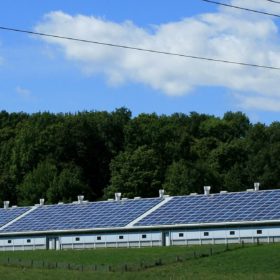
Scientists from the Lawrence Berkeley National Laboratory have defined a utility-ownership model for rooftop PV that could help to mitigate impacts on no-solar consumers. According to their findings, a similar model could raise utility shareholder earnings by 2% to 5%, relative to a no-solar scenario.
Researchers from the U.S. Department of Energy’s Lawrence Berkeley National Laboratory have developed a new business model that could help power utilities to more effectively manage distributed-generation solar assets.
They presented their findings in “Benefits and costs of a utility-ownership business model for residential rooftop solar photovoltaics,” which was recently published in Nature Energy. The new approach suggests a series of advantages that power utilities may gain from owning and operating rooftop PV systems. They include siting at targeting locations with relatively low interconnection costs, deferring future network upgrades, visibility and control over distributed-generation assets by utility system planners, lower solar-installation costs, and the possibility of improving services in underserved market.
Policy considerations
The scientists said that they considered all possible impacts on utility ratepayers and shareholders.
“Fundamental policy questions exist about the appropriateness of using utility ratepayer funds for what is otherwise a competitive service,” they explained. “Indeed, in some restructured markets, regulated utilities are prohibited by law from owning generation assets, whether large scale or distributed.”
They said that another important issue is the need to evaluate whether each utility has the organizational capabilities to own and operate distributed-gen solar projects. The proposed model aims to define a utility-owned, 20-year residential rooftop solar program. The researchers claim that the model is different from more-conventional ownership structures, as the PV systems are connected directly to the utility’s grid and are owned by the utilities themselves.
The program is modeled on those of U.S. utilities Arizona Public Service and the Los Angeles Department of Water and Power. In their service areas, utility-owned PV installations are connected directly to the utility grid and provide no direct reduction in the host customer’s billed consumption. Under such schemes, utilities must pay for O&M, administrative, and procurement costs.
“Under the scenarios where rooftop solar is owned by the host customer or some third party, we assume that the systems are installed behind the customer meter, and that the host customer is compensated under a typical net metering arrangement, whereby each kilowatt-hour generated offsets a kilowatt-hour of billed retail electricity sales,” the researchers said.
The group believes that a similar model may raise utility shareholder earnings by 2% to 5% relative to a no-solar scenario. “This compares to a 2% loss of earnings when an equivalent amount of rooftop solar is deployed but owned by non-utility parties,” they added.
Consumer costs
Under this program, utility customers that do not own solar PV installations will keep paying the highest prices, with average electricity bills increasing by 1% to 3%, which compares to 2% under non-utility ownership structures.
“This business model is therefore unlikely to meaningfully mitigate equity or cost-shifting concerns associated with residential rooftop solar,” the researchers said.
In order to reduce the impact on no-solar consumers, the scientists suggested the procurement of rooftop solar at particularly low costs and the net reduction of non-participant bills. They also concluded that behind-the-meter battery storage may be key to ensuring transmission and distribution deferral value, as such systems can offer grid services and are dispatchable.
“Allowing direct utility ownership of behind-the-meter battery storage could better align utility shareholder interests with those of their ratepayers, to an even greater extent than this analysis shows to be possible for rooftop solar,” the researchers said.
Lắp đặt điện mặt trời Khải Minh Tech
https://ift.tt/2X7bF6x
0906633505
info.khaiminhtech@gmail.com
80/39 Trần Quang Diệu, Phường 14, Quận 3
Lắp đặt điện mặt trời Khải Minh Tech
https://ift.tt/2ZH4TRU
Không có nhận xét nào:
Đăng nhận xét